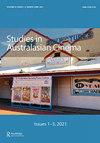Manifesto as method for a queer screen production practice
IF 0.7
0 FILM, RADIO, TELEVISION
引用次数: 0
Abstract
ABSTRACT The authors reflect on creating a collaborative creative work that was developed both with, and as, a manifesto. Using queer theory as a framework, the authors track the process of developing and deploying a 14-step manifesto and outline their aims for queering screen production through creative practice. The project applies Baker’s (2011) call for a queer-ing of practice-led research, enacting a performative bricolage with a focus on queer screen production that is concerned with more than representation. The resulting 14-minute assemblage film outlines its thesis within an experimental, non-linear structure, comprising clips from the individual authors’ previously produced screen works, interplayed with new content, personal archive and textual elements. It combines the authors’ separate practices in filmmaking, screenwriting, mobile media and documentary in ways that deviate from mainstream categorisations, production hierarchies and workflows. Firstly, the manifesto is situated among others that outline strategies of disruption and resistance. Then, framed by the manifesto steps, the authors reflect on the film’s disruption of dominant narrative models in the context of queer theory’s critiques of heteronormative temporality. They then draw some conclusions around the possibilities of ‘manifesto as method’, and the implications for narrative disruption, queer screen production, and creative practice more broadly.《宣言》作为酷儿银幕制作实践的方法
作者反思了如何创造一种合作的创造性作品,这种作品既是与宣言一起开发的,也是作为宣言开发的。以酷儿理论为框架,作者追踪了发展和部署一个14步宣言的过程,并通过创造性实践概述了他们对酷儿电影制作的目标。该项目应用了Baker(2011)对以实践为主导的酷儿研究的呼吁,制定了一个专注于酷儿屏幕制作的表演拼凑,而不仅仅是表现。由此产生的14分钟的组合电影在一个实验性的非线性结构中概述了它的论点,其中包括来自个人作者以前制作的屏幕作品的片段,与新的内容,个人档案和文本元素相互作用。它结合了作者在电影制作、编剧、移动媒体和纪录片方面的不同实践,偏离了主流的分类、制作层次和工作流程。首先,宣言与其他概述破坏和抵抗策略的宣言并列。然后,在宣言步骤的框架下,作者反思了电影在酷儿理论对异性恋规范时间性的批评背景下对主流叙事模式的破坏。然后,他们围绕“宣言作为方法”的可能性,以及对叙事中断、酷儿电影制作和更广泛的创作实践的影响,得出了一些结论。
本文章由计算机程序翻译,如有差异,请以英文原文为准。
求助全文
约1分钟内获得全文
求助全文

 求助内容:
求助内容: 应助结果提醒方式:
应助结果提醒方式:


